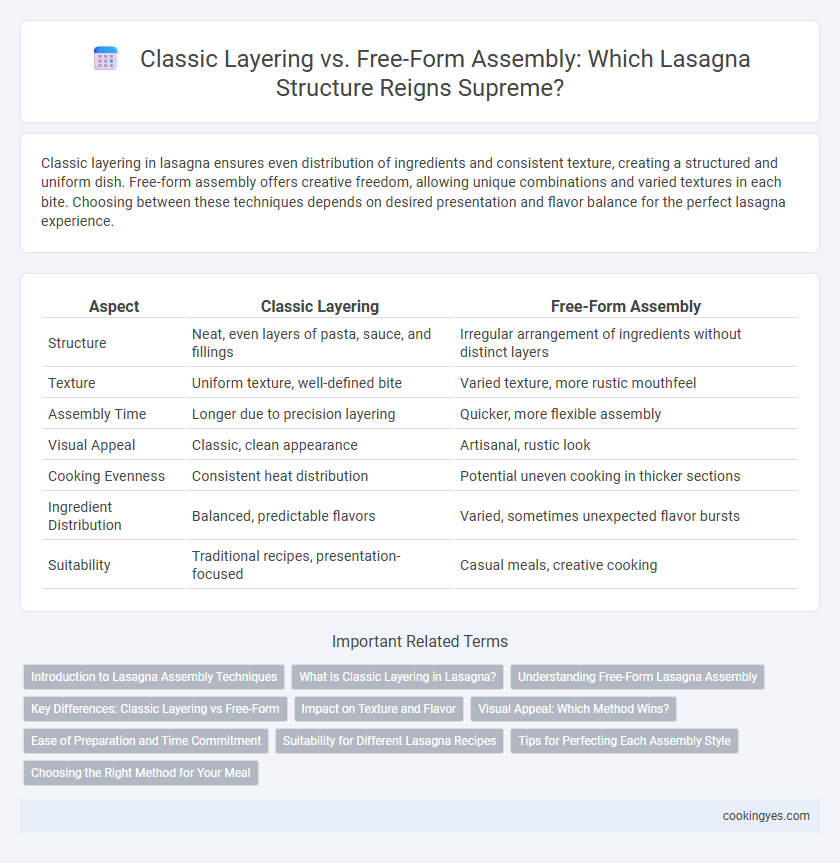Classic layering in lasagna ensures even distribution of ingredients and consistent texture, creating a structured and uniform dish. Free-form assembly offers creative freedom, allowing unique combinations and varied textures in each bite. Choosing between these techniques depends on desired presentation and flavor balance for the perfect lasagna experience.
Table of Comparison
| Aspect | Classic Layering | Free-Form Assembly |
|---|---|---|
| Structure | Neat, even layers of pasta, sauce, and fillings | Irregular arrangement of ingredients without distinct layers |
| Texture | Uniform texture, well-defined bite | Varied texture, more rustic mouthfeel |
| Assembly Time | Longer due to precision layering | Quicker, more flexible assembly |
| Visual Appeal | Classic, clean appearance | Artisanal, rustic look |
| Cooking Evenness | Consistent heat distribution | Potential uneven cooking in thicker sections |
| Ingredient Distribution | Balanced, predictable flavors | Varied, sometimes unexpected flavor bursts |
| Suitability | Traditional recipes, presentation-focused | Casual meals, creative cooking |
Introduction to Lasagna Assembly Techniques
Classic layering in lasagna involves precisely stacking sheets of pasta, sauce, cheese, and fillings to create distinct, even layers that ensure consistent texture and flavor distribution. Free-form assembly allows for a more rustic approach, mixing ingredients loosely without strict layering, resulting in varied textures and a heartier bite. Understanding these techniques influences the final dish's structural integrity and mouthfeel, tailoring the lasagna to traditional or creative culinary preferences.
What Is Classic Layering in Lasagna?
Classic layering in lasagna involves stacking ingredients in a precise order to create distinct layers of pasta, sauce, cheese, and filling, ensuring even distribution of flavors and textures. This method typically includes alternating sheets of lasagna noodles with ricotta cheese mixture, meat sauce, and shredded mozzarella, which allows the dish to hold its shape when baked. The structured layering promotes consistent cooking and a visually appealing cross-section when served.
Understanding Free-Form Lasagna Assembly
Free-form lasagna assembly allows for more creativity by layering ingredients without strict order, resulting in varied textures and flavors in each bite. This method emphasizes flexibility, with ingredients like ricotta, marinara, and noodles distributed unevenly to enhance taste complexity. Understanding free-form assembly helps chefs balance components for a rustic, artisanal lasagna experience that contrasts traditional, uniform layering.
Key Differences: Classic Layering vs Free-Form
Classic layering in lasagna involves distinct, evenly stacked layers of pasta, sauce, cheese, and fillings, creating a structured and uniform texture that holds shape when sliced. Free-form assembly mixes ingredients more loosely, allowing for a rustic texture with varied distribution of flavors and a less rigid appearance. The key difference lies in precision and consistency for classic layering versus flexibility and variation in free-form assembly.
Impact on Texture and Flavor
Classic layering in lasagna creates distinct, harmonious layers of pasta, sauce, cheese, and fillings, resulting in a balanced texture with each bite offering structural integrity and consistent flavor distribution. Free-form assembly produces a more rustic texture with varied mouthfeel and intensified flavor contrast as ingredients blend unpredictably, enhancing complexity but sacrificing uniformity. The choice between techniques directly impacts lasagna's sensory experience, with classic layering favoring orderly layers and free-form assembly emphasizing bold, mixed flavors.
Visual Appeal: Which Method Wins?
Classic layering in lasagna creates evenly stacked, uniform layers that enhance visual appeal through consistent, clean lines and a structured presentation. Free-form assembly offers a rustic, artisanal look with varied textures and an inviting, handmade appearance that appeals to casual dining aesthetics. For formal occasions or photogenic dishes, classic layering wins in visual appeal, while free-form assembly suits a more relaxed, approachable style.
Ease of Preparation and Time Commitment
Classic layering in lasagna ensures uniform cooking and consistent texture, making it ideal for precise portion control but requires more time and careful assembly. Free-form assembly offers a quicker, less structured approach with irregular layering, which reduces preparation time but may result in uneven cooking and texture. Choosing between these methods balances the ease of preparation against desired lasagna structure and cooking consistency.
Suitability for Different Lasagna Recipes
Classic layering in lasagna provides a structured approach ideal for traditional recipes featuring alternating layers of pasta, bechamel, meat sauce, and cheese, ensuring even cooking and balanced flavors. Free-form assembly suits rustic or experimental recipes, allowing flexibility in ingredient distribution and thickness for casseroles with varied textures or non-traditional fillings. Choosing between classic layering and free-form assembly depends on recipe complexity, desired texture, and presentation preferences.
Tips for Perfecting Each Assembly Style
Classic layering ensures even distribution of flavors by alternating pasta sheets, sauce, cheese, and fillings, achieving a balanced and firm lasagna structure that holds together when sliced. For free-form assembly, focus on maintaining consistent proportions of ingredients and gently spreading each layer to prevent sinking or uneven cooking. Use high-quality ricotta cheese mixed with egg for better binding in free-form styles, while carefully draining fillings in classic layering helps avoid excess moisture that can make the dish watery.
Choosing the Right Method for Your Meal
Classic layering in lasagna ensures a uniform texture and balanced flavor distribution by alternating pasta sheets, sauce, cheese, and fillings in precise layers, ideal for traditional presentations. Free-form assembly offers flexibility and creativity, allowing for varied ingredient placement and less rigid structure, perfect for casual meals or unique flavor combinations. Selecting the right method depends on your desired texture, presentation style, and ease of preparation for the occasion.
Classic Layering vs Free-Form Assembly for Lasagna Structure Infographic

 cookingyes.com
cookingyes.com